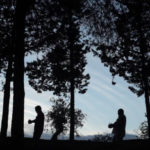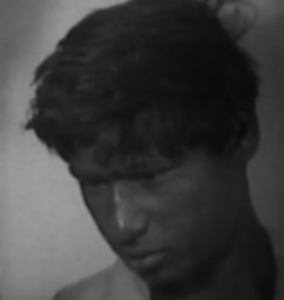Romani Cinema (1)
Ethnographic Descriptions
« Only to the Jews and the Gypsies it happened to be industrially exterminated as people who have been denied the right to share land with other human beings »
Elisabeth de Fontenay,
Actes de naissance. Entretiens avec Stéphane Bou (Seuil, 2011)
Figurative Defamations and Documented Rectifications
The intersection between the avant-garde cinematography and Romani families (Roma, Manush, Gitanos, Gypsies, Travellers, Sinti, Zingari) combines two forms of critical initiatives: visual replicas on the one side, developed against the figurative defamations to which these families are subject, as a work of documented objection and rectification, putting the ideological dimension of imagery into the light; and on the other side, the descriptions and statements made freely, outside of any polemic or prejudice.
The modern history of figurative defamations “starts with the invention of photography” (Menelaos Karamaghiolis, Rom, 1989), e.g. with the images of Romani families, massively co-produced by the police systems, mass media and cultural industry. To the visual regime of the majority of images – that, since the end of the 19th century, have pulled back the comprehension of Romani families into social and moral miserabilism – are opposed the way that documentarists such as Pilar Arcila & Jean-Marc Lamoure, Caterina Pasqualino & Chiara Dambrosio, look at, listen and pay attention to these families. These filmmakers disprove the photogenic aspect of misery, especially thanks to the voice of said families and the emic poetry through which they see life. Additionally, in the face of the fantasy imagery picturing Romani families that is deployed on postcards from the beginning of the 20th century on, to the most recent cinematic fables, artists like Daniel Gontz and Menelaos Karamaghiolis manage to put a twist on these sometimes almost mythological topoi. From a historical standpoint, in the continuity of Peter & Zsóka Nestler, Charmant Rouge dedicates himself to classificatory and police-related images that have accompanied the monitoring, administrative control, detention and later the deportation of Zigeuner by the German authorities. Charmant Rouge also exhumes a voyeuristic aspect from the Austrian archives where Romani are reduced to touristic curiosities, ontologically comparable to prisoners in a zoo. Similarly to Yervant Gianikian and Angela Ricci Lucchi, Charmant Rouge and Menelaos Karamaghiolis show how amateur images gain visual sovereignty within the controlling environment itself.
The Romani Cinema presented here claims on the contrary plurality, complexity and creative initiatives from the Romani families. To begin with, films have affirmed a culture of contact between Romani families and avant-gardes. This contact culture, which appeared with literary bohemianism in the 19th century, lasts into the 21st century, as films by Ben Vine, Tomáš Doruška or Mona Vătămanu and Florin Tudor show it. Their films oppose ostracism and discrimination based on the show that is expulsion and the overpowering longevity of silver halide photography. As part of his cooperation with the Shukar Collective, partly made of gypsy musicians, Daniel Gontz oppose a secular, visual regime to the powerful and ephemeral energy of a music score by VJing. The conditions of the possibility for an encounter become a stake of documentation work, thanks to the ethnologists from the CNRS: Yasuhiro and Kimie Omori undertake a visual improvisation in 16 minutes; Caterina Pasqualino and Chiara Dambrosio study the forms of resistance inspired by flamenco music and the political history of Granada. With Pilar Arcila, the encounter becomes a common enterprise: Le Pendule de Costel (2013) establishes an editing method that is neither alternating nor parallel, but that we could qualify as auxiliary, between her own Super 8 images and the digital ones of a gypsy family. The result is a high density visual experience that is at the same time ethical and aesthetic. With Tomáš Doruška, the encounter becomes a political upsurge. For the first time, a film in Romanès language was broadcasted without subtitles on Czech public television.
As of the end of the 1970s, a properly Romani contemporary art form is developed. It is represented by the works of Katelan Foisy, Delaine Le Bas, Damian James Le Bas and Phillip Osborne, as well as the female authors of the collective film Sárral kevert vér (2014). Their work features the way Romani communities experience time – as a collective memory (Chuvihoni), highly poetic (Rokkerenna), searching for remnants and signs of the English-Romani culture at the heart of the modern, urban space (Delaine Le Bas’ Gypsylands). These works are also the traces of a memory (Sárral kevert vér) and culture (Witches Compass) that were lost following the genocide and the migratory movements it induced. It is through the contact with historical avant-gardes in general, and Taylor Mead in particular, that Katelan Foisy reinvents her history and culture (For a Gadjo). This Romani Cinema repoliticizes and reconfigures space, history, experience, and writing. It brings us a counter-culture “at the avant-garde of our people, of Europe, of the world” (Ethel Brooks), the science of this people about which has been made notice that it is the only one never to have started a war.
Paris, June 24th 2015
Jonathan Larcher, Nicole Brenez.
Romani I. Ethnographic Descriptions
Mour Djiben. Ma vie de tzigane manouche (Mour Djiben. My tzigane gypsy life)
by Yasuhiro Omori & Kimie Omori
France / 1976 / 59’ / 16mm
« The everyday life of a Manush family moving with a horse-drawn wagon in the centre of France, filmed by a ethnologist. “Is it the authors’ status of foreigners that give the dialogues such sincerity, and such tolerance as they record intimate sequences? Coming from a country where no Gypsies live, they do not hold conscious or subconscious prejudices against the Manush, commonly shared by sedentary Europeans. Their work is truly remarkable in its accuracy. Within the very limits of its ambitions, this film is a good ethnographic document, both in the development of the theme and its technical qualities”.
(Études Tsiganes n° 3, 1977)
***
Olvido (Oblivion)
by Ben Vine
Spain / 2006 / 3’22 / S8
« Shot in a single sequence on expired super 8 mm film in the very same flea market where I bought it, Olvido is a reflection on the ambiguous status and the role of these street musicians in Spanish society. Questioning my own gaze as well, this film is a reflection on what society considers as art, as culture and as trash. Notions which intertwine. » (Ben Vine)
***
Tierra Inquieta (Unquiet Earth)
by Caterina Pasqualino & Chiara Ambrosio
United Kingdom / 2015 / 74’ / digital
Unavalaible on line.
« To deal with the 2007 economic crisis which provoked a vast social misery, neighbours from Caseria De Montijo (Granada, Spain) decided to come together and get organized, and planted a communal orchard on land that previously served as an illegal dump. In this orchard our protagonists – Antonio, Oscar and Santiago – want to believe in the possibility of a fairer world, and cast their lives as art. Out of work, they could have easily gotten depressed. Instead, they chose to take action. This orchard in Caseria is, like the protagonists, a film subject in itself. Alive just like the men who grow it, the orchard of Caseria “tiene memoria”, it remembers the violence that scarred this region for so many years. Just a few miles away from the orchard of Caseria are the mass graves of Viznar, where the bodies of the Republicans slaughtered by Franco’s soldiers during the Civil War of 1937 still lay unburied. In Caseria they say that these bodies may have been a good fertilizer for the soil. The three characters in the film perform a “Water Ceremony” to ward off (conjure) the drought on this fertile land with a turbulent history, and bless it anew. » (Caterina Pasqualino & Chiara Ambrosio)
Images : Mour Djiben. Ma vie de tzigane manouche / Olvido (Oubli) / Tierra Inquieta (Unquiet Earth).








